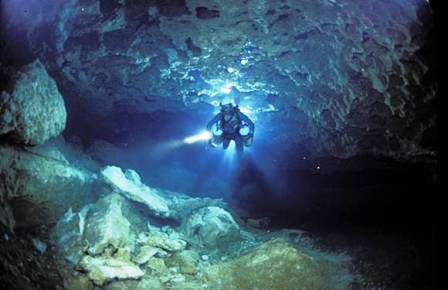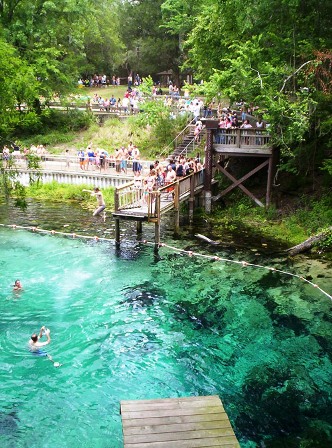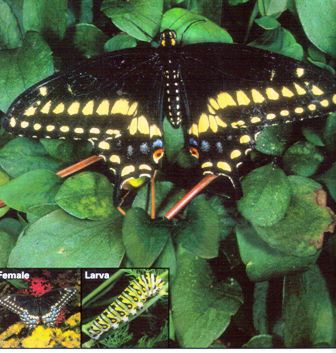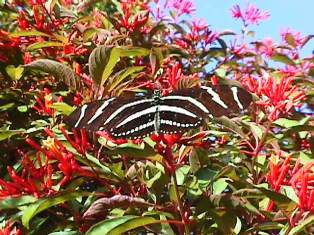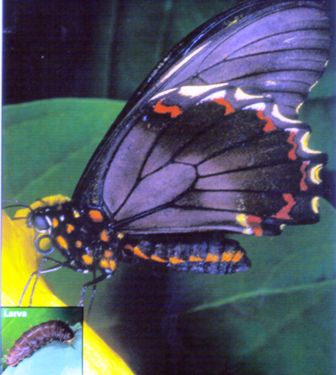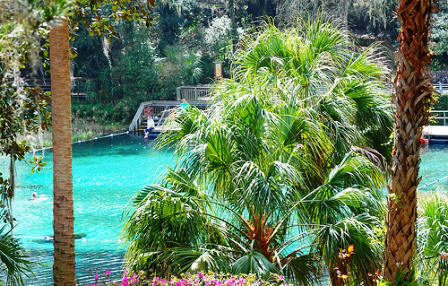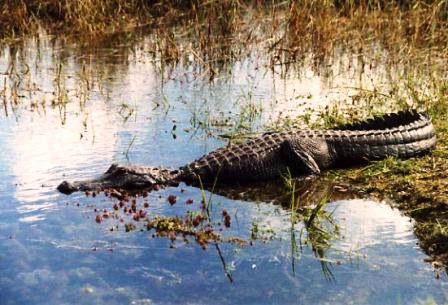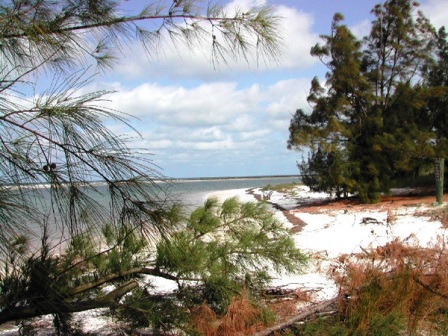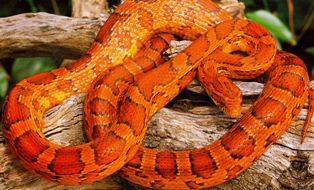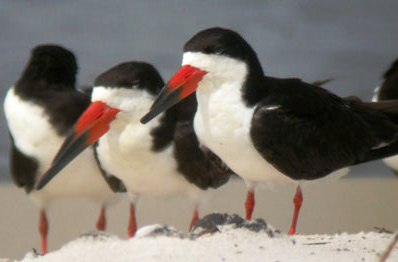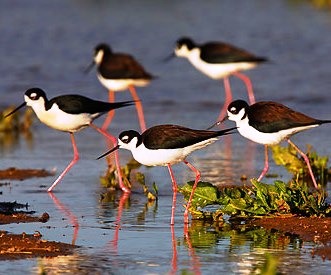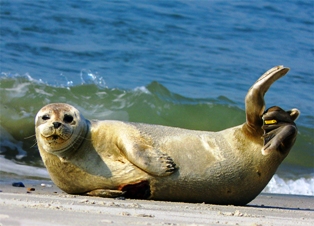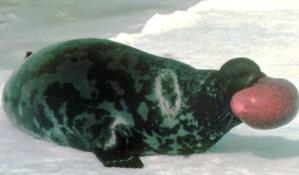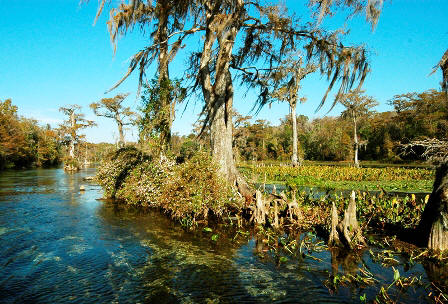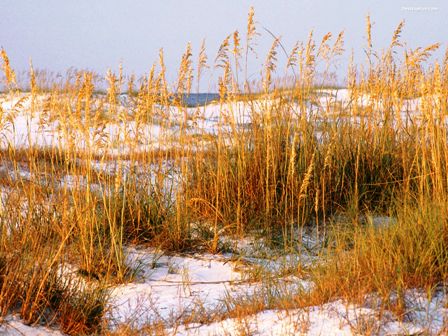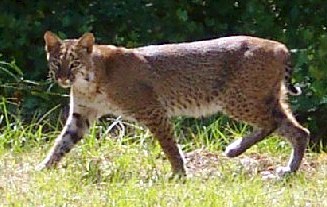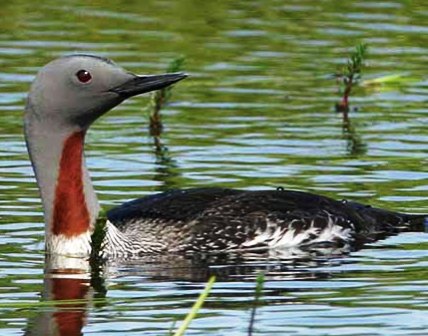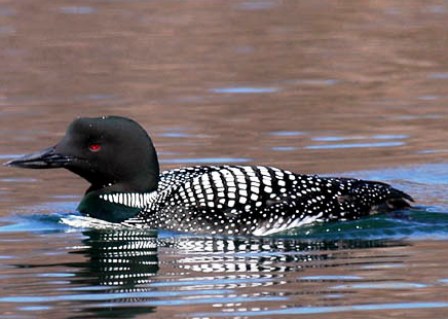Monday, August 15, 2016
Nature Spot of the Week: Fanning Springs
This week's pick is in honor of my son Sean who just started working as a writer for the Chiefland Citizen. Fanning Springs is a Florida city in Gilchrist and Levy counties. The population was 737 at the 2000 census, with an estimated 2004 population of 800. Fanning Springs Florida is famous for the springs and the Suwannee River. Located on the central, west coast of Florida on the Suwannee River. Fanning Springs is breath taking at first sight. It has a large basin with very clear water and excellent scenery all around. Depths vary from 2 to 21 feet depending on the river height. Water discharges from visible sand boils and small cracks in the rocks that surround the bottom.
Fanning Springs consists of two springs or pools, each with a run discharging to the Suwannee River. Fanning is about 200 ft wide and 350 ft long. Its vent, near the southeast wall, is about 30 feet in diameter. Pool depth is greatest near the vent, 18 ft or more, depending on river stage. The vent area is nearly funnel shaped, with a sandy bottom and limestone sides. The spring run, about 100 ft wide, 8 ft deep, and 100 ft long, flows westward. Little Fanning Spring has a nearly horizontal opening into a limestone hillside. It flows nearly southwest and the water is slightly turbulent for about 10 ft beyond the vent. The run widens from about 10 to 30 feet, and in a short distance turns west and joins the Suwannee River about 1,000 feet downstream. Fanning Springs is used primarily as a recreational area. Diving is allowed with a small additional fee, although it is primarily used for certification dives for local shops.
Fanning Springs Florida is also home to the 1836 site of Fort Fanning, located on a high Suwannee River bluff. Fort Fanning was built in 1838 during the Second Seminole War. The Fort was originally called "Palmetto", but was renamed in honor of Colonel Alexander Campbell Wilder Fannin. Made of wood, and situated in a warm humid climate, remnants of the actual fort have long since disappeared. Colonel Fannin served under General Andrew Jackson in the First Seminole War. As a lieutenant at the beginning of the Second Seminole War he was noted for outstanding service when he lead a charge in a battle near the Withlacoochee River. His objective, during the Second Seminole War, was to capture Seminoles for deportation to the West.
Many visitors enjoy the picnic area, playground, volleyball court or use the park's large open areas for ball games, throwing Frisbees, and also for events. There is a canoe/kayak launch available, a nature trail and a boardwalk that overlooks the river. In the summer the gazebo at the end of the boardwalk is a fine place to watch sturgeon jumping. Manatees are often seen in the springs during the winter months and occasionally in the summer. White-tailed deer, gray squirrels, red-shouldered hawks, pileated woodpeckers, and barred owls are some of the other animals seen in the park. The Fanning Springs River walk, as well as the Nature Coast Greenway Trail are great walking trails and the perfect spot to enjoy some Floridian nature.
Monday, May 23, 2016
Florida butterflies
With the warm climate, butterflies are often in flight year round in Floridian Nature. From the Giant Swallowtail to the Little Metalmark, the state
has a wealth of flittering, fluttering, flappers, and gliders
brightening the landscape. There are more than 17,000s different
species, or types, of butterflies. They come in many colors and live in
very different types of climates. In Florida over 180 different
butterflies have been recorded. Within that mix, some 40 are considered
either unique to the state or occur mostly within its boundaries,
Who doesn't want to see beautiful butterflies visiting their Florida garden? Planning a butterfly garden in your yard helps attract a wide variety of butterflies found in Florida nature. Creating a butterfly garden means choosing plants that are high in nectar and plants in colors of red and purple that butterflies find irresistible.
The Polydamus Swallowtail lacks the characteristic hindwings tails common to most other North American members of the swallowtail family. This trait combined with it's broad, yellow wing span of 4.0- 5.0 inches, makes this butterfly easy to identify. The Polydamus Swallowtail is a fast and powerful flier with a preference to open areas. Primarily a tropical butterfly, it is rarely found north of the Florida border. This is a common butterfly of suburban and urban gardens. Adult polydamus are good colonizers and readily disperse long distances in search of suitable hosts.
Who doesn't want to see beautiful butterflies visiting their Florida garden? Planning a butterfly garden in your yard helps attract a wide variety of butterflies found in Florida nature. Creating a butterfly garden means choosing plants that are high in nectar and plants in colors of red and purple that butterflies find irresistible.
The Polydamus Swallowtail lacks the characteristic hindwings tails common to most other North American members of the swallowtail family. This trait combined with it's broad, yellow wing span of 4.0- 5.0 inches, makes this butterfly easy to identify. The Polydamus Swallowtail is a fast and powerful flier with a preference to open areas. Primarily a tropical butterfly, it is rarely found north of the Florida border. This is a common butterfly of suburban and urban gardens. Adult polydamus are good colonizers and readily disperse long distances in search of suitable hosts.
Monday, April 25, 2016
Florida Nature Spot of the Week: Rainbow Springs
The Rainbow River is located in the southwest corner of Marion County
Florida. It is formed by a first magnitude spring that is ranked fourth
in the state for volume of discharge. In addition to the springs located
at the headwaters, there are many smaller springs that discharge from
numerous caves, rock crevices, and sand boils the entire length of the
river. The Rainbow River is a gently winding river that is 5.7 miles
long and merges with the Withlacoochee
River at Dunnellon Florida. The headwaters is the anchor for the
Rainbow Springs State Park. This first magnitude spring is not one large
vent but is numerous vents that issue 400 - 600 million gallons of
crystalline water every day.
Rainbow Springs State Park is comprised of 1,459.07 upland acres (which
includes around 100 acres of wetlands) and 12.83 submerged acres. The
most significant natural feature is the first magnitude headspring basin
which produces between 400 - 600 million gallons of fresh water per day,
forming the Rainbow River. The looking glass waters of Rainbow Springs
come from several vents, not one large bubbling spring. The river itself
supports a wide variety of fish , wildlife, and plants, many within easy
viewing by visitors. In total, the park contains 11 distinct natural
communities, including sandhills,
flatwoods, upland mixed forests, and
hydric hammocks. Visitors are able to see a variety of wildflowers
in season; oak,
longleaf pines, magnolia,
dogwood, redbud, and hickory trees;
gray squirrels,
red-shoulder hawks,
swallowtail kites, barred
owls,
whitetail deer, and a wide variety of
wading birds. The relative peace and quiet of the winter season
offers much for the nature enthusiast. There is an interpretive room
located in the visitor center displaying historical, natural, and
cultural resources of the park.
Monday, April 11, 2016
Floridian Nature spot of the week: The Everglades
Everglades National Park, the largest subtropical wilderness in the United States,
boasts rare and endangered species. The largest body of water within the
park is Florida Bay, which extends from the mangrove swamps of the
mainland's southern tip to the Florida Keys. Over 800 square miles of
marine ecosystem lies in this range. Coral, sponges, and seagrasses
serve as shelter and food for crustaceans and mollusks, which in turn
are the primary food source for larger marine animals.
Sharks, stingrays, and barracudas also live in
this ecosystem, as do larger species of fish that attract sport fishing.
Pelicans,
shorebirds, terns, and
black skimmers are among the birds frequenting park
shorelines. Everglades National Park contains the southern 25 percent of
the original
Everglades marshland region of southwestern Florida. The park
visited by one million people each year and has been declared an
International Biosphere Reserve, a World Heritage Site, and a Wetland of
International Importance, only one of three locations in the world to
appear on all three lists. The Everglades is a slow-moving system of
rivers, flowing southwest at about .25 miles per day, fed by the
Kissimmee River and Lake Okeechobee.
Unlike most other U.S. national parks, Everglades National Park was
created to protect a fragile ecosystem instead of safeguarding a
geographic feature. Floridians hoping to preserve at least part of the
Everglades first proposed that the area become a national park in 1923.
Five years later, the Florida state legislature established the Tropical
Everglades National Park Commission to study the formation of a
protected area. Thirty-six species designated as threatened or protected
live in the park, including the
Florida panther, the
American crocodile, and the
West Indian manatee. Protecting the largest U.S. wilderness area
east of the Mississippi River, the park is the most significant breeding
ground for tropical wading birds in North America, and contains the
largest
mangrove ecosystem in the
western hemisphere. More than 350 species of birds, 300 species of fresh
and saltwater fish, 40 species of mammals, and 50 species of reptiles
live within Everglades National Park. All of southern Florida's fresh
water is recharged by the park, including that of the Biscayne Aquifer.
Monday, April 4, 2016
Florida Nature Spot of the Week: Anclote Key Florida
Spring is in the air and it is the perfect time to explore Floridian Nature! The island of Anclote Key houses both the Anclote Key State Preserve and the Anclote National Wildlife Refuge. Accessible only by private boat, this island park has a lighthouse and wildlife area that is a sanctuary for rare and endangered species. Blue-green Gulf waters lap gently along the preserve´s beautiful four-mile-long beach. About 1,000 years ago this island was pushed up from the Gulf floor to rest on a limestone platform. Its geologic growth hasn’t stopped. Recent research has documented a 30 percent increase in the size of Anclote since 1957.
Much of the 180 acres encompassed by Anclote Key is very damp and marshy, which makes it hard to travel around unless you walk along the sand beaches. The color of the water resembles that of the Florida Keys because it is a turquoise-color. The island's intercoastal side, or eastern side, has no beach. Instead, it has mangroves and mushy mud, almost like quicksand. The western side, or Gulf of Mexico side, however, is sandy from the waves. There are more of the taller trees on this side, like palms and pines rather than shrubs and mangroves. From the top of the lighthouse, you can actually see the distinct line in which the island is split between short shrubs and tall trees. One of the wonderful things about this quiet, peaceful paradise is that you can literally pull up to an un-inhabited part of the island, set up your chairs, and enjoy your own personal part of the beach.
Tuesday, March 15, 2016
Red Rat Snakes (Corn Snakes)
Snakes are a big part of Floridian nature and while some of them are deadly most are not. The Red Rat Snake, often called the corn snake in
Florida, live near pinelands, hardwood hammocks, swamps, agricultural
fields, and residential areas. Corn snakes are one of the most colorful
snakes in Florida. Adult Red rat Snakes are orangish-brown with black
bordered orange, red, or brownish blotches. The belly usually is a black
and white checkerboard pattern, though orange may also be present. The
underside of the tail has 2 black stripes. Adult red rat snakes reach a
length of 18-44 inches. Red rat Snakes are found throughout peninsular
Florida. The species ranges west to Louisiana to north to southern New
Jersey.
Our daughter-in-law has a pet rat snakes and we built her a custom snake home for Christmas. it was a big hit and you can see that Ginger really enjoys her new home with plenty of room to stretch out!
Our daughter-in-law has a pet rat snakes and we built her a custom snake home for Christmas. it was a big hit and you can see that Ginger really enjoys her new home with plenty of room to stretch out!
Monday, February 22, 2016
Shorebirds
Shorebirds are a common sight in Floridian nature. Black skimmers “skim” the surface of the water with
black-tipped bright red bills. The lower half of the bill is longer than
the upper, allowing it to cut through the water and dip down to grab
small fish encountered near the surface. Adult plumage is black above,
white below and this striking combination, coupled with the brightly
colored bill, makes it easy to spot the birds as they hunt over the
water or loaf on the beach with other seabirds and shorebirds. Black
skimmers, and least, royal and sandwich terns nest in colonies in the
open sand on beaches, sandbars, and dredge material islands. Their nests
are built on the ground and often consist of simple scrapes in the sand.
(Due to habitat loss, a very small percentage of black skimmers also
nest on gravel roofs!) Black skimmers rely on camouflage or group
mobbing to protect their nests. Breeding colonies of black skimmers can
be found along Florida’s Gulf and Atlantic coasts. Watch for them in the
early evening when they actively feed, and scan flocks of loafing birds
for this uncommon coastal resident.
With its black and white plumage, long, thin red legs, and long neck, the Black-necked Stilt is both striking and delicate in appearance. It is a medium-sized shorebird with a black needle-like bill, black or dark brown upperparts, and a white breast. The iris is red, and there is a white spot above the eye. Breeding males have glossy black wings, back, and back of neck, and a pink tinge on the breast. Non-breeding males lack the glossiness and pink tinge. Adult females have a brown tinge to the back. Juveniles have brown upperparts with buff feather margins, and a white trailing edge to the wing in flight. Five species of rather similar-looking stilts are recognized in the genus Himantopus. They have the second-longest legs in proportion to their bodies of any bird, exceeded only by flamingos. This bird's habitat includes salt ponds, rice fields, shallow lagoons, and mangrove swamps. Black-necked Stilts most often consume aquatic invertebrates. They also sometimes eat tadpoles, tiny fish, and seeds of aquatic plants. Pairs form on wintering grounds, during migration, or on breeding grounds; pairs remain monogamous throughout the breeding season. Both sexes choose the nest site, which is often on a small island in the marsh.
With its black and white plumage, long, thin red legs, and long neck, the Black-necked Stilt is both striking and delicate in appearance. It is a medium-sized shorebird with a black needle-like bill, black or dark brown upperparts, and a white breast. The iris is red, and there is a white spot above the eye. Breeding males have glossy black wings, back, and back of neck, and a pink tinge on the breast. Non-breeding males lack the glossiness and pink tinge. Adult females have a brown tinge to the back. Juveniles have brown upperparts with buff feather margins, and a white trailing edge to the wing in flight. Five species of rather similar-looking stilts are recognized in the genus Himantopus. They have the second-longest legs in proportion to their bodies of any bird, exceeded only by flamingos. This bird's habitat includes salt ponds, rice fields, shallow lagoons, and mangrove swamps. Black-necked Stilts most often consume aquatic invertebrates. They also sometimes eat tadpoles, tiny fish, and seeds of aquatic plants. Pairs form on wintering grounds, during migration, or on breeding grounds; pairs remain monogamous throughout the breeding season. Both sexes choose the nest site, which is often on a small island in the marsh.
Monday, February 8, 2016
Florida Marine Mammals: Seals
Seals live in the oceans of both hemispheres and are mostly confined to
polar, sub-polar, and temperate climates, with the exception of the more
tropical monk seals. True seals inhabit all oceans, except the Indian
Ocean. Some species live in inland lakes in Siberia, Russia, and
Finland. Seals forage, search for food, at sea, but haul out (get out of
the water) to land to breed, molt, or shed fur, and rest. Seals eat
mostly fish, but also feed on krill, squid, octopuses, and other seals.
True seals congregate on land or ice to breed and molt. The males and
females of some species migrate, travel, separately from breeding to
foraging areas, some traveling as far south as Florida. Others species
do not migrate.
Adult hooded seals have black heads and silver-gray coats with dark blotches of varying sizes and shapes across their bodies. Pups are called "blue-backs" for their coat of blue-gray on their backs and whitish bellies; this coat is shed after 14 months of age when they molt. Adult males measure around 8 feet long and weigh about 660 pounds. Adult females are noticeably smaller, measuring around 7 feet in length and weighing about 440 pounds. The hooded seal is unique for the elastic bi-lobed nasal cavity, or "hood", that adult males can inflate and extend from the front of their face to the top of their head. Sexually mature males also have an elastic nasal septum, which, when inflated, resembles a pinkish red balloon, to attract females' attention during mating season and to display hostility towards other males. Hooded seals usually dive for food to depths of about 325-1,950 feet for 15 minutes at a time. Adult hooded seals feed on squid, starfish, mussels, and fish such as Greenland halibut, redfish, cod, capelin, and herring. Hooded seals live on drifting pack ice and in deep waters. Some drift far away from their northern habitat towards much warmer regions every year, but they survive best in colder climates, as heat and constant sun exposure is harmful to them. Hooded seals are migratory and can wander long distances; they have occasionally been found as far south as Florida, California, and the Caribbean.
Adult hooded seals have black heads and silver-gray coats with dark blotches of varying sizes and shapes across their bodies. Pups are called "blue-backs" for their coat of blue-gray on their backs and whitish bellies; this coat is shed after 14 months of age when they molt. Adult males measure around 8 feet long and weigh about 660 pounds. Adult females are noticeably smaller, measuring around 7 feet in length and weighing about 440 pounds. The hooded seal is unique for the elastic bi-lobed nasal cavity, or "hood", that adult males can inflate and extend from the front of their face to the top of their head. Sexually mature males also have an elastic nasal septum, which, when inflated, resembles a pinkish red balloon, to attract females' attention during mating season and to display hostility towards other males. Hooded seals usually dive for food to depths of about 325-1,950 feet for 15 minutes at a time. Adult hooded seals feed on squid, starfish, mussels, and fish such as Greenland halibut, redfish, cod, capelin, and herring. Hooded seals live on drifting pack ice and in deep waters. Some drift far away from their northern habitat towards much warmer regions every year, but they survive best in colder climates, as heat and constant sun exposure is harmful to them. Hooded seals are migratory and can wander long distances; they have occasionally been found as far south as Florida, California, and the Caribbean.
Monday, January 25, 2016
Florida's Dune & Maritime Ecosystem
Dunes and Maritime Forests are part of the Coastal Ecosystem of Floridian nature. Florida's coastal ecosystems are one of the greatest assets that Florida has. With more coastline than any other state in the contiguous United States, they are a source of economic, environmental and recreational benefit. People come from all over the world to visit the beautiful Florida beaches. In addition to people sea turtles also come from all over the world to lay their eggs on Florida's Atlantic coast, one of only a handful of places in the world that they come. Landward of the fore-dune is the maritime forest. Technically part of the dune system, this coastal zone habitat has permanent vegetation with tree and understory layers.
Maritime forests dominated by broadleaved evergreen trees and shrubs occur in a discontinuous narrow band along the barrier islands and on the adjacent mainland from North Carolina to Florida. The flora and fauna of maritime forests typically consist of a distinctive subset of the regional biota that is particularly well adapted to survive the elevated salt content, limited availability of fresh water, soil erosion and dune migration, periodic seawater inundation, and wind damage associated with oceanic storms.
The beach and dune habitat includes the unvegetated beach, and the dune zone up to the point where the stable vegetation of the maritime forests begin. Landward of the non-vegetated beach zone, is the foredune area. The species inhabiting this zone vary depending on location. Sea oats are found in this zone throughout the state and there will be several other, low growing species in association with this species.
Generally, the vegetation is sparse closest to the active beach and transitions to an association of grasses and shrubs. The species composition varies depending on location. Along the northeast beach wax myrtle, silverling, southern red cedar, and cabbage palm are dominant. The southeast coast has purple muhly grass, sea grape, saw palmetto, Spanish bayonet, and agave. nickerbean, bay cedar, catsclaw, buckthorn, lantana, joewood, and several species of grasses dominate the southwest coastline while woody goldenrod, rosemary and Gulf Bluestem make up the dune transition zone in the Panhandle.
Tuesday, January 12, 2016
Florida bobcats
Bobcats are a common cat in Floridian nature and are sometimes even confused for a panther siting. The easiest way to tell the two cats apart is the famous "bobbed tail "of the bobcat. I encountered a very large bobcat while walking through the woods on a nature walk. I had stopped to enjoy the view, looking down on an old limestone pit and when I got up and turned the next corner a bobcat was standing in the path. The cat looked as surprised to see me as I was to see her. She was a large cat, coming up to my waist in height, but there was no mistaking the bobbed tail which was about half the length of a normal one. She was gracious enough to go behind a bush and allow me to pass by without an incident to either of us. Due to its abundance in Florida, the bobcat is not listed as endangered nor threatened. However, it is classified as a fur-bearing game animal by the Florida Game and Freshwater Fish Commission and can only be hunted during certain months of the year. In recent surveys, Florida was the only state to show a decline in bobcat numbers in recent years.
As we see in this photograph that was in the Citrus County Chronicle, the bobcat's environment and man's environment often overlap, According to FWC, bobcats den and rest in thick patches of saw palmetto and dense shrub. Bobcats tend to weigh between 12 pounds and 28 pounds, sport a short “bobbed” tail, and prey on small animals such as rabbits, rodents, birds and occasionally deer. They help control populations of other species that may be considered household or yard pests, including rodents and rabbits.
Wednesday, January 6, 2016
Florida loons
Florida is home to two native loons; the common loon and the red throated loon. The red-throated loon is the smallest, slightest of the
divers. It is distinctive among loons not only in size, but also in
behavior, vocalizations, locomotion, and other aspects of life history.
The Red-throated Loon, unlike other loons, does not need to patter on
the water's surface on a long takeoff, but rather can take flight
directly from land if necessary. Most loons must paddle furiously across
the surface of the water before becoming airborne, but the small
Red-throated can practically spring directly into the air from land, a
useful ability on its tundra breeding grounds. Whereas only males of
other loon species vocalize, both male and female Red-throated Loons make calls, often together. The Red-throated Loon is
the only loon that regularly forages far from its breeding territory,
returning from distant lakes or the sea with fish for the young. Unlike
other loons, the Red-throated Loon does not carry its young on its back.
The common loon, with its exquisite breeding plumage and yodel-like call, has come to symbolize wilderness and northern lakes to many people. But once the breeding season ends in Alaska, Canada and the northern U.S., loons head south to winter along the Atlantic and Gulf coasts. Thousands of loons dot the bays and open oceans surrounding Florida and are a very visible part of the winter coastal landscape. While in Florida, both male and female winter loons have a white underside and a gray-brown head, neck and back. In late spring along the Gulf Coast and in north Florida lakes, a few birds acquire breeding plumage just prior to their migration north.
The common loon, with its exquisite breeding plumage and yodel-like call, has come to symbolize wilderness and northern lakes to many people. But once the breeding season ends in Alaska, Canada and the northern U.S., loons head south to winter along the Atlantic and Gulf coasts. Thousands of loons dot the bays and open oceans surrounding Florida and are a very visible part of the winter coastal landscape. While in Florida, both male and female winter loons have a white underside and a gray-brown head, neck and back. In late spring along the Gulf Coast and in north Florida lakes, a few birds acquire breeding plumage just prior to their migration north.
Subscribe to:
Posts (Atom)
